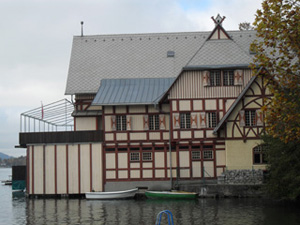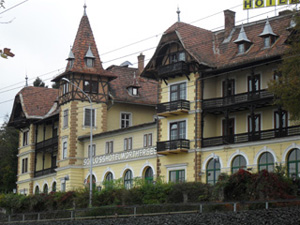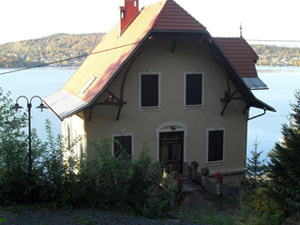| Card n. | Description | Locality | Linked sites |
| 101 | The Historical Architecture of Wörthersee Lake | Wörthersee | |
| Architecture art history (ASA) |
 |
 |
 |
| 30. Boat-and clubhouse - Klagenfurt | 31. Hotel Wörthersee | 39. Summerhouse of the composer Gustav Mahler - Klagenfurt/Maiernigg |
- Description
- How to get there
- Interesting facts
- Bibliography
Following the inauguration, in 1864, of the “southern imperial royal” railway line, many Viennese came to Carinthia and had luxury villas built around the Wörthersee lake. The architecture of the Wörthersee area blends very attractively into the landscape, and the villas, mostly built as holiday homes, were designed taking into account the lake, the water and the natural landscape, with gardens built around the villas, shelters for boats and little chalets on the lakeshore. The porches and terraces look onto the lake and the facades feature attractive bow windows and gables, often enhanced with romantic elements. The architect that best represented this style was Franz Baumgartner (Vienna, 27 June 1876 – Velden, 14 October 1946). He designed Villa Edelweiss in Pörtschach (1910), Villa Almrausch (1913), the adjoining Villa Turkovic and Villa Luckmann in 1913, Villa K. [Eugenie] (1926); on the outskirts of Klagenfurt, again on the banks of the lake, he designed the nautical circle (1909), while in the town he designed the “Künstlerhaus" (house of the artists), the Hotel Kointsch in Velden in 1909 – which may be considered the prototype for the architecture of the Wörthersee area – and the Forstsee hydroelectric plant (1925), an industrial building in a “villa” style.
In addition to Baumgartner, numerous other architects worked around the lake. Particularly worth mentioning are Josef Victor Fuchs, who designed Villa Seeblick (1888) and Villa Seewarte (1893) in Pörtschach for the mother of the President of the Carinthia Region Lemisch, the Werzer-Bad bathing establishment in 1895, the only surviving construction in the area built in wood using a pilework system, Villa Romanini, Villa Venezia and Villa Wörth; Friedrich Theuer, who designed Villa Schwarzenfels in 1894, Villa Siegel in 1900 and Villa Mahler in 1901 in Maiernigg, the summer residence of the great composer Gustav Mahler (Kalischt, 7 July 1860 – Vienna, 18 May 1911), who was also a regular visitor to the Dobbiaco area; Alexander Graf, a major name in Viennese architecture, who in 1895 designed Wörth Castle in Pörtschach and built the Volksoper on the Ringstrasse in Vienna; the Hamburg architect Zenkonski, who designed the small “Miramare” castle in 1898 for the Mayor of Klagenfurt, on the picturesque rocks of the Reifnitz bay, clearly influenced by the better-known castle of the same name in Trieste; Wilhelm Hess, who had earlier designed the Parkhotel in Pörtschach for the Viennese ceramics manufacturer Carl Ernst Wahliss, a pioneer of tourism in the Wörthersee area, and created the Hotel Wörthersee along the eastern bank of the lake, in the municipality of Klagenfurt, in 1897: a monumental construction in which wood was used to build the porches, trellises and balconies.
The historical and modern architectures along the Wörthersee lakeshore can be reached by following the A23 Udine – Tarvisio and then the E55 / A2 in Austria.
From the province of Belluno, via Cortina (SS51), the Monte Croce Comelico (SS52) or Misurina (SP49) passes will take you into the province of Bolzano in the Upper Pusteria (SS49) area, and from there across the border at Prato Drava, go along the E66 – 100 until Lienz and then in the direction of Spittal to the Drava – Klagenfurt.
ACCESSIBLE: These are buildings of various different kinds, and as is also the case in Italy, those that are publicly owned are open and may be visited, while the historical villas and modern private homes are obviously closed to the public, although the architectural features of interest here can be admired from the lake
MUNICIPALITY AND PLACES: Auen, Dellach, Maria Wörth, Sekirn, Maiernigg, Klagenfurt, Krumpendorf, Pörtschach, Velden.
GEOGRAPHICAL COORDINATES: reference is to the centre of Wörthersee lake
46°37’’30’ N – 14°09’’11’ E
or X 433958 N or Y 5164264
PROVINCE: Carinthia
FILE COMPILED BY: Alfarè - Lonzi
Wörthersee lake is in Carinthia, a region popular with tourists not least because of the other lakes that can be found there: Faaker, Keutschacher, Klopeiner, Millstatt, Ossiacher, Pressegger and Weissen, as well as many other smaller ones.
The region is also crossed by the Drava and by numerous affluents such as the Möll, Lieser, Gurk, Lavant and Gail, which lend their names to the respective valleys.
Like the province of Belluno, the Carinthia region boasts a wealth of establishments and structures that exploit hydroelectric energy, serving much of Austria as well as the other European countries that border on it.
The house of Carinthian architecture, D. Muller, H. Kramer, B. Mack. Klagenfurt, 2009.
http://www.woerthersee-architektur.at

